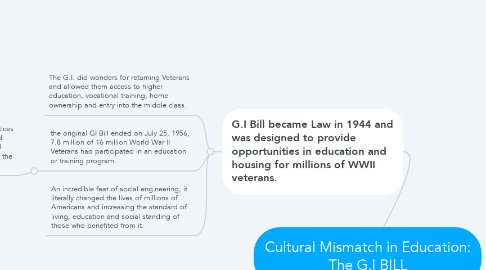
1. Education: The GI BIll Offered the Opportunity of College and/or Vocational Training
1.1. In the peak year of 1947, Veterans accounted for 49 percent of college admissions.
1.1.1. By 1946, only one fifth of the 100,000 blacks who had applied for educational benefits had been registered in college
1.1.2. Only seven states offered postbaccalaureate training, while no accredited engineering or doctoral programs were available for blacks
1.1.2.1. The Effect of education on Cultural Mismatch is two-fold
1.1.2.1.1. As less people of color enter higher education, there less opportunities to influence the policies which effect students.
1.1.2.1.2. A majority of pre-service teachers note that they little to no opportunities to learn with and from other students who come from different backgrounds.
1.1.3. Separate but, Equal condemned blacks to substandard educations. Leaving many unable to take advantage of the few opportunities available.
2. G.I Bill became Law in 1944 and was designed to provide opportunities in education and housing for millions of WWII veterans.
2.1. The G.I. did wonders for returning Veterans and allowed them access to higher education, vocational training, home ownership and entry into the middle class.
2.2. the original GI Bill ended on July 25, 1956, 7.8 million of 16 million World War II Veterans had participated in an education or training program.
2.2.1. Due to Laws such as Jim Crow and practices such red-lining, de facto segregation and other forms of discrimination, blacks and others were unable to take advantage of the benefits of the GI Bill for generations.
2.3. An incredible feat of social engineering, it literally changed the lives of millions of Americans and increasing the standard of living, education and social standing of those who benefited from it.
3. Ecomonics: The GI BIll Offered the Opportunity of Home-Ownership
3.1. Wealth building is Generational and with it comes opportunity.
3.2. A family's largest asset is their home, often something they can pass down to their children.
3.2.1. Of the first 67,000 mortgages fewer than 100 were received by Non-Whites
3.2.2. Practices such as Red-lining prevented blacks from receiving mortgages or residing in desirable neighborhoods.
3.2.2.1. The biggest factors contributing to Cultural Mismatch is to groups being separated from and unfamiliar with each other.
3.2.3. Due to social and economic policies entire populations of people were and continue to live separate from one another.

